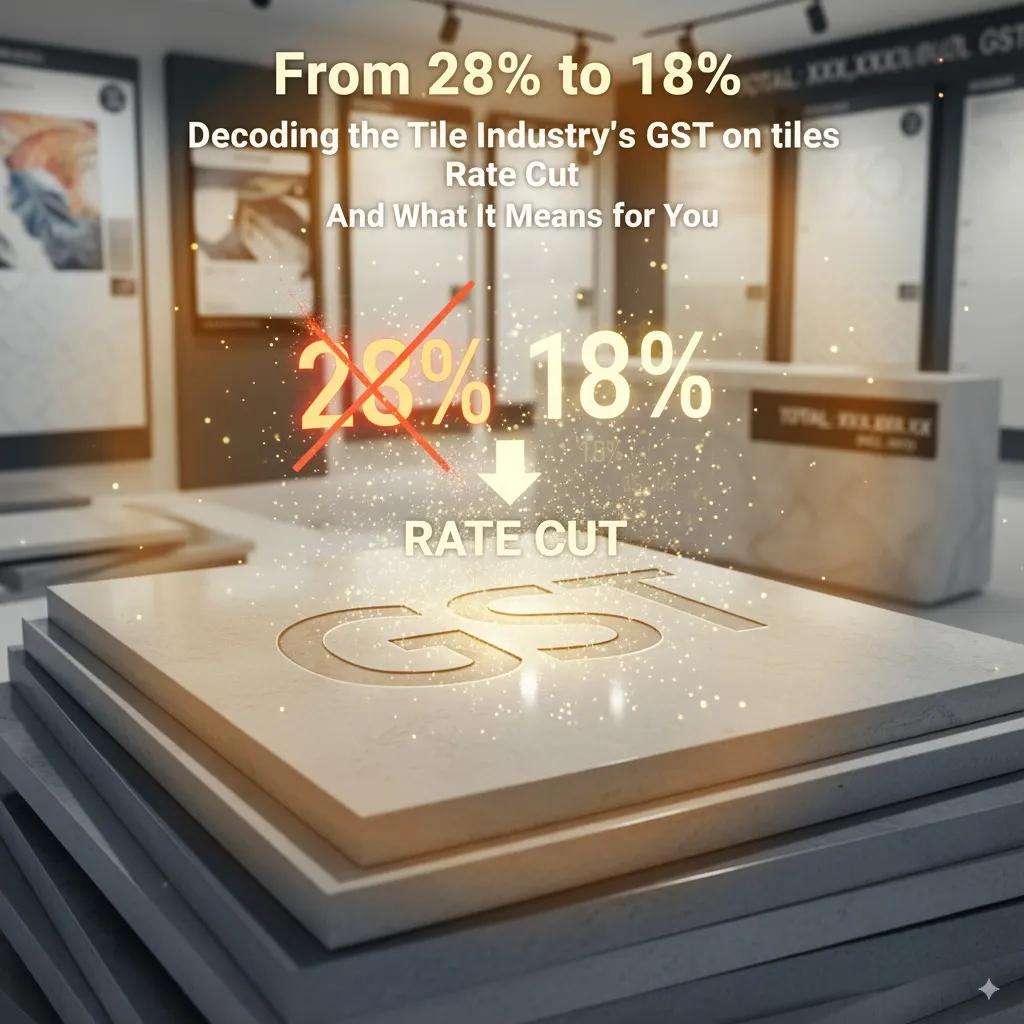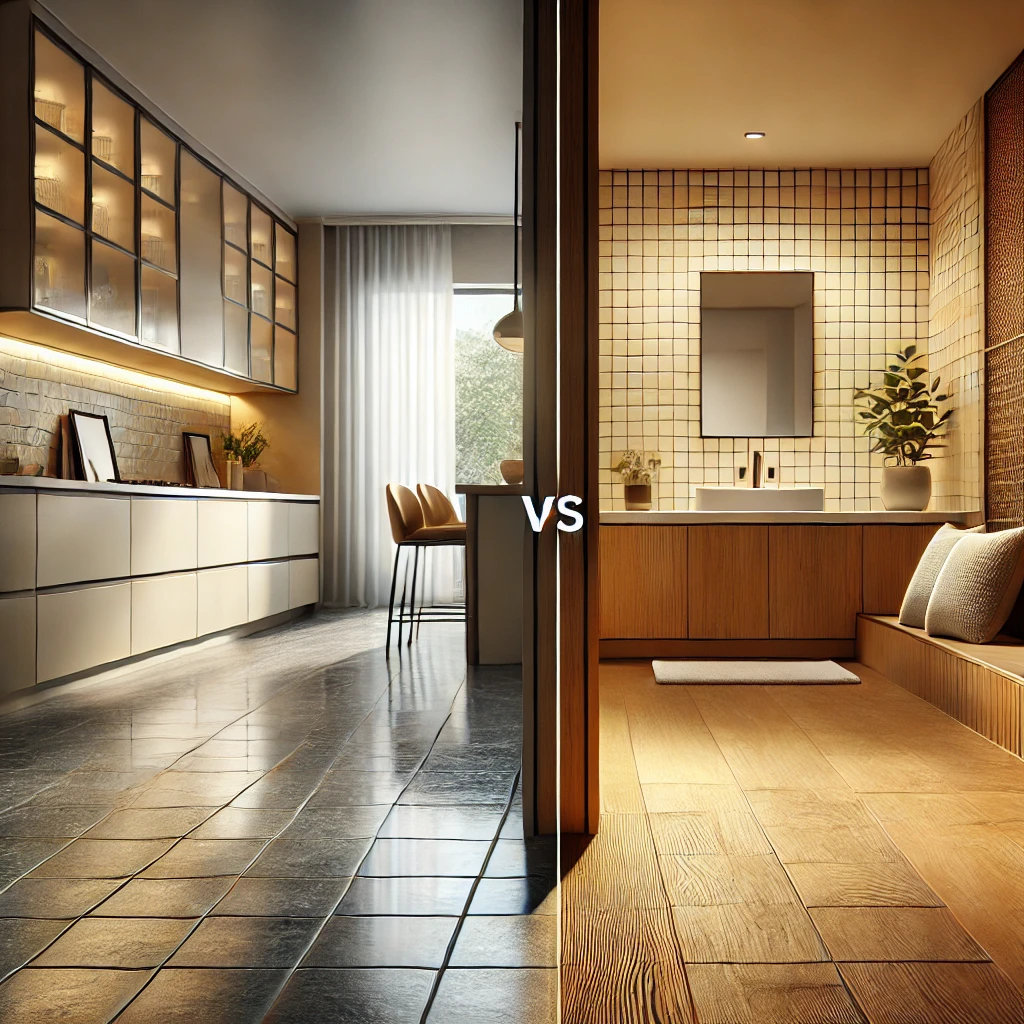Do you remember that GST on tiles feeling? Standing in a tile showroom, surrounded by stunning designs, calculating the square footage for your dream kitchen or bathroom, and then… the final bill. For years, that bill came with a hefty 28% Goods and Services Tax (GST), a figure that often turned excitement into anxiety. It was a tax rate that put beautiful, durable tiles in the same bracket as luxury cars and five-star hotel stays. Seemed a bit much for something that’s literally the foundation of a clean and functional home, didn’t it?
Well, the landscape has dramatically changed. In a landmark decision that sent waves of relief across the country, the GST Council slashed the rate on ceramic and vitrified tiles from a whopping 28% down to a much more reasonable 18%. This wasn’t just a minor tweak in a tax code; it was a seismic shift for homeowners, builders, manufacturers, and the entire Indian construction ecosystem.
But what does this 10% drop actually mean for you? Is it just a simple discount, or are the effects more profound? How does it impact the bustling tile manufacturing hubs of Morbi? And how can you, as a consumer, ensure this benefit actually reaches your pocket?
In this definitive guide, we’re going to pull back the curtain on the tile industry’s GST break. We’ll explore the struggles of the 28% era, celebrate the widespread benefits of the new 18% slab, and provide you with actionable checklists and insights to navigate this new, more affordable world of tiles. So, whether you’re planning a full-scale renovation or just tiling a small backsplash, stick around. This is the information you need to make smarter, more cost-effective decisions.
The 28% GST Challenge: Why the Original Rate Was a Hurdle for the Tile Industry
Before we can truly appreciate the 18% rate, we need to understand the problems caused by the initial 28% slab. When GST was rolled out in 2017, it aimed to unify a fragmented tax system. However, the initial classification of goods placed tiles—a fundamental building material—in the highest tax bracket, creating a cascade of negative consequences.
The “Sin Tax” Misconception: Were Tiles Really a Luxury?
The 28% GST slab was unofficially dubbed the “luxury Tiles” or “sin” tax bracket. It was reserved for items like premium cars, tobacco products, and high-end consumer electronics. Placing ceramic and vitrified tiles in this category was, to put it mildly, a disconnect from reality.
Think about it: are tiles a luxury? In modern construction, they are an absolute necessity.
- Hygiene and Health: Tiled surfaces in kitchens and bathrooms are non-porous, easy to clean, and prevent the growth of mold and bacteria. They are a cornerstone of a sanitary living environment.
- Durability and Longevity: Unlike other flooring options that may need frequent replacement, properly installed tiles can last for decades, offering long-term value and reducing waste.
- Affordability (Fundamentally): At their core, basic ceramic tiles are one of the most cost-effective and durable flooring solutions available, crucial for affordable housing projects.
By branding tiles as a “luxury,” the 28% tax rate created a perception that was entirely at odds with their essential role in housing. It was like putting a luxury tax on cement or bricks. This fundamental misclassification was the root of many of the industry’s struggles.

Impact on Consumers: How High GST Inflated Home Renovation Budgets
For the average Indian family, building or renovating a home is one of the biggest financial undertakings of their lives. Every single percentage point on the cost of materials matters. The 28% GST on tiles directly inflated these costs, forcing many to make difficult choices.
Let’s break it down with a simple, real-world example.
Imagine you’re tiling a medium-sized area of your home, say 500 square feet.
- Scenario 1: With 28% GST
- Let’s assume the base price of a decent quality vitrified tile is ₹50 per square foot.
- Base Cost: 500 sq. ft. x ₹50/sq. ft. = ₹25,000
- GST @ 28%: ₹25,000 x 0.28 = ₹7,000
- Total Tile Cost: ₹32,000
This ₹7,000 wasn’t a small amount. It could be the cost of a new water heater, a high-quality kitchen sink, or the entire paint job for a room. Homeowners were faced with a dilemma:
- Compromise on Quality: Opt for cheaper, lower-grade tiles to offset the high tax, potentially leading to issues with durability and finish down the line.
- Reduce the Scope: Tile a smaller area than originally planned, leaving parts of the home with less desirable flooring.
- Delay the Project: Postpone renovations altogether, waiting for a time when they could afford the inflated costs.
This high tax burden was a significant pain point, acting as a direct barrier to improving living standards for millions.
Struggles of Manufacturers and Dealers: The Ripple Effect of a High Tax Rate
The problems weren’t confined to consumers. The entire supply chain, from the factory floor to the retail showroom, felt the strain of the 28% GST rate.
For manufacturers, especially the small and medium-sized enterprises (SMEs) that form the backbone of India’s tile industry (particularly in the Morbi, Gujarat cluster), the challenges were immense:
- Suppressed Demand: High end-consumer prices naturally led to lower sales volumes. When customers are hesitant to buy, production lines slow down, and growth stagnates.
- Working Capital Blockage: A higher GST rate meant more money was tied up in the tax component of their inventory. This strained working capital, making it harder to invest in new machinery, R&D, or even manage day-to-day operational costs.
- Intense Price Competition: To attract price-sensitive customers, manufacturers were often forced to absorb some of the tax burden, squeezing their already thin profit margins.
Dealers and retailers faced a similar set of issues. They had to maintain expensive inventory, and slower sales meant their capital was locked up for longer periods. It created a high-pressure, low-margin environment that stifled growth and expansion.
The Unorganized Sector’s Unfair Advantage
One of the most damaging, albeit unintended, consequences of the high GST rate was that it inadvertently encouraged the unorganized sector. The 28% tax created a massive price gap between compliant businesses (who charged GST and filed returns) and non-compliant players (who operated in cash and evaded taxes).
This created an unlevel playing field. Honest, tax-paying businesses were at a significant price disadvantage. A consumer, often unaware of the long-term implications, might be tempted to buy from an unorganized seller offering a “cheaper” cash deal, thereby depriving the government of revenue and supporting an ecosystem of tax evasion. This situation undermined the very purpose of GST, which was to formalize the economy and create a transparent, unified market. The 28% rate, in this context, was not just a burden; it was a barrier to formalization.

The GST Council’s Landmark Decision: Moving Tiles to the 18% Slab
After years of representation from industry bodies, consumer feedback, and a growing realization of the economic drag caused by the 28% rate, the GST Council made the pivotal decision to move tiles into the 18% slab. This wasn’t a sudden move but a calculated one, aimed at rectifying the initial misclassification and stimulating a key sector of the economy.
What Prompted the Change? Understanding the Government’s Rationale
Several key factors drove the government and the GST Council to reconsider the tax rate on tiles. It was a confluence of economic logic, industry feedback, and national priorities.
- Industry-Wide Representation: Tile manufacturing associations, particularly from the Morbi hub, were relentless in their efforts. They presented data-backed arguments showcasing how the high tax rate was stifling growth, promoting the unorganized sector, and making Indian tiles less competitive globally.
- Boosting the Housing and Construction Sector: The government’s flagship “Housing for All by 2022” (now extended) and other affordable housing schemes were being directly impacted by high input costs. Tiles are a major component of construction costs. Lowering the GST on tiles was a direct way to reduce the overall cost of building a house, making homes more affordable and giving a much-needed boost to the real estate sector. A 2021 report by the Confederation of Real Estate Developers’ Associations of India (CREDAI) highlighted that taxes on building materials accounted for over 30% of a project’s cost, making such rate cuts crucial.
- Correcting the “Luxury” Anomaly: There was a clear acknowledgment that branding tiles as a luxury item was incorrect. Policymakers recognized their essential nature in modern life, justifying their place in a standard tax slab rather than the highest one.
- Increasing Tax Compliance and Revenue: This might seem counterintuitive, but lowering the tax rate can sometimes lead to higher overall tax collection. By reducing the rate from 28% to 18%, the government narrowed the price gap between the organized and unorganized sectors. This made it far more attractive for consumers to buy from GST-compliant dealers, ensuring they received a proper invoice and warranty. More businesses joining the formal economy and higher sales volumes for compliant players would ultimately lead to a more stable and predictable revenue stream for the exchequer.
A Detailed Breakdown: Which Tiles Are Covered Under the 18% GST Rate?
Clarity is key in taxation. The GST reduction to 18% was comprehensive and covered the vast majority of tiles used in construction and renovation. This was classified under Chapter 69 of the HSN (Harmonized System of Nomenclature) code, the global standard for classifying goods.
The 18% GST rate applies to:
- Ceramic Tiles: This includes a wide range of products like glazed and unglazed ceramic flooring tiles, wall tiles, and mosaic cubes.
- Vitrified Tiles: These are a type of ceramic tile with very low porosity, making them stain-resistant and extremely durable. The 18% rate applies to all variants, including polished, unpolished, and glazed vitrified tiles (GVT/PGVT).
- Porcelain Tiles: Similar to vitrified tiles, these are known for their strength and are also covered under the 18% slab.
- Roofing Tiles: Earthen or clay roofing tiles, essential for traditional and modern architecture, were also moved to the lower slab.
Essentially, if you are buying tiles for your floors, walls, bathrooms, kitchen, or roof from a registered dealer, you should be charged GST at 18%. Always check your invoice to ensure the correct HSN code and GST rate are applied.
The Immediate Aftermath: How the Market Reacted to the GST Reduction
The announcement was met with widespread optimism, but the transition wasn’t without its initial hiccups.
- Positive Consumer Sentiment: The news was a breath of fresh air for potential homebuyers and renovators. The prospect of a direct 10% tax saving reignited many stalled projects and prompted others to start planning.
- Industry Celebration: For manufacturers and dealers, it was a moment of vindication. The move was seen as a government acknowledgment of their vital role in the economy. Share prices of listed tile companies saw a positive surge, reflecting investor confidence.
- Transitional Challenges: The biggest immediate challenge was managing inventory. Dealers who had purchased stock with a 28% tax component had to figure out how to sell it at a new price reflecting the 18% rate. While the GST framework allows for claiming Input Tax Credit (ITC) on old stock, it required careful accounting and documentation, causing some temporary confusion in the supply chain.
- Price Adjustments: Most organized players and reputable brands were quick to pass on the benefit to the consumers. They issued new price lists, and the difference was immediately visible in quotes and bills, solidifying trust with their customer base.
Overall, the market quickly stabilized. The temporary logistical hurdles were overcome, paving the way for a more robust, transparent, and consumer-friendly tile market.
Beyond the Price Tag: The Widespread Benefits of the 18% GST on Tiles
The most obvious benefit of the GST cut is a lower price. But the positive ripple effects extend far beyond the customer’s wallet, creating a win-win scenario for the entire economic ecosystem. Let’s dissect the multi-layered advantages this tax rationalization has brought.
For Homeowners & Builders: Your Money Now Goes Further
This is the most direct and celebrated impact. The 10% reduction in the tax rate translates to a significant saving on the final cost. Let’s revisit our 500 square feet tiling project.
- Scenario 1: With 28% GST
- Base Cost: ₹25,000
- GST @ 28%: ₹7,000
- Total Tile Cost: ₹32,000
- Scenario 2: With 18% GST
- Base Cost: ₹25,000
- GST @ 18%: ₹25,000 x 0.18 = ₹4,500
- Total Tile Cost: ₹29,500
That’s an immediate saving of ₹2,500 on a ₹32,000 purchase. For a full house renovation where the tile budget can run into lakhs, the savings can be substantial, often running into tens of thousands of rupees.
What does this mean for you?
- Upgrade Your Choice: The money saved can be used to upgrade to a higher quality tile, perhaps a premium vitrified tile instead of a standard ceramic one, without increasing your overall budget.
- Expand Your Project: You can now afford to tile that extra balcony or utility area you had previously decided to skip.
- Reallocate Funds: The savings can be channeled into other aspects of the renovation, like better plumbing fixtures, higher-quality lighting, or more premium paint.
- Reduced Loan Burden: For those taking loans for construction or renovation, lower material costs mean a smaller principal amount, leading to lower EMIs and interest payments over time.
For Tile Manufacturers: A New Era of Growth and Competitiveness
The GST cut was a massive shot in the arm for the Indian tile industry, which is the second-largest in the world. According to the Indian Council for Research on International Economic Relations (ICRIER), the industry is projected to grow significantly, and this tax reform is a key catalyst.
- Demand Stimulation: Lower prices directly translate to higher demand. This allows manufacturers to increase their capacity utilization, leading to better economies of scale and improved profitability. A factory running at 90% capacity is far more efficient than one running at 60%.
- Level Playing Field: The reduced tax rate shrinks the price advantage of the unorganized sector. This encourages more players to become GST-compliant, leading to a more formalized and healthier industry structure. It allows quality-focused, compliant manufacturers to compete fairly on the merits of their products, not just on price.
- Enhanced Global Competitiveness: With lower domestic taxation, Indian tiles become more price-competitive in the international market. This boosts export potential, helping the “Make in India” initiative and earning valuable foreign exchange for the country. Manufacturers can now quote more aggressive prices to buyers in the Middle East, Europe, and Africa.
- Investment in Innovation: With improved cash flow and higher demand, manufacturers have more capital to invest in Research & Development (R&D). This fuels innovation in tile design, such as creating larger slab tiles (e.g., 8×4 feet), developing anti-bacterial glazes, or pioneering new printing technologies for more realistic textures.
For Dealers and Retailers: Streamlined Operations and Increased Sales
The middlemen—the dealers and retailers—are crucial links in the supply chain, and they too have benefited significantly.
- Increased Footfall and Sales: Lower prices attract more customers, leading to a direct increase in sales volume. A bustling showroom is a healthy showroom.
- Faster Inventory Turnover: With higher demand, inventory moves off the shelves much faster. This is a critical metric for retail health. Faster turnover means working capital is freed up more quickly and can be reinvested in new stock or business expansion. The risk of having dead stock or outdated designs is also reduced.
- Simplified Accounting: While any tax system has complexities, operating within a single, lower-rate slab is simpler than dealing with the pressures of a high-tax environment. It also encourages transparent billing, which builds long-term customer trust.
For the National Economy: A Boost to Construction and “Make in India”
On a macro level, the decision to lower GST on tiles has had a positive cascading effect on the Indian economy.
- Construction Sector Growth: The construction industry is one of the largest employment generators in the country. Lowering the cost of a key building material like tiles stimulates construction activity, which in turn creates jobs for laborers, masons, plumbers, electricians, and transporters.
- Formalization of the Economy: As mentioned earlier, the move encourages businesses to enter the formal, tax-paying economy. This broadens the government’s tax base and leads to more transparent economic activity.
- Support for MSMEs: The Indian tile industry is dominated by Micro, Small, and Medium Enterprises (MSMEs), particularly in Gujarat’s Morbi region. The GST cut provides these businesses with the oxygen they need to grow, compete, and thrive, which is critical for inclusive economic growth.
In essence, the GST reduction on tiles was not merely a tax adjustment; it was a strategic economic lever that has helped unlock value and stimulate growth at every level of the pyramid.

Navigating the Change: Practical Guidance for Every Stakeholder
Knowing that the GST rate has been reduced is one thing; ensuring you benefit from it and navigate the transition smoothly is another. Here’s a practical playbook for homeowners, retailers, and manufacturers.
Homeowner’s Checklist: How to Ensure You’re Getting the GST Benefit
As the end consumer, you are the ultimate beneficiary of this tax cut. However, you need to be a savvy buyer to make sure the savings are passed on to you transparently.
Here’s a simple checklist to follow when you go tile shopping:
- [✔] Ask for a Detailed Quote: Don’t just accept a final “per square foot” price. Ask the retailer to provide a detailed quotation that clearly breaks down the base price of the tile, the GST rate (should be 18%), and the final amount.
- [✔] Always Insist on a GST Invoice: This is non-negotiable. A proper GST invoice is your proof of purchase and a guarantee that the tax you’ve paid is going to the government. It should clearly mention the seller’s GSTIN, the HSN code for the tiles, the taxable value, and the CGST (9%) and SGST (9%) or IGST (18%) charged. Avoid cash transactions without a bill, as you’ll have no guarantee of the product’s quality or the tax rate applied.
- [✔] Compare Apples to Apples: When comparing prices from different dealers, make sure you are comparing the final, all-inclusive prices (including 18% GST). Some dealers might quote a lower base price but then add other charges, so the final figure is what matters.
- [✔] Verify the HSN Code: While you don’t need to be a tax expert, a quick look at the invoice for an HSN code starting with ‘6907’ or ‘6908’ confirms that you’re buying ceramic or vitrified tiles, which fall under the 18% slab.
- [✔] Question Any Discrepancies: If you see a 28% GST charge on your tile invoice, question it immediately. It’s possible the retailer is using an old billing system or is trying to overcharge. Politely but firmly point out that the rate for tiles has been reduced to 18%.
A Guide for Retailers: Managing Old Stock and New Pricing Structures
For retailers, the transition period can be tricky, especially when it comes to inventory purchased at the older, higher tax rate.
- Understand Transitional Credits: The GST framework has provisions for claiming Input Tax Credit (ITC) on the tax you paid on your existing stock. It’s crucial to work with your accountant or tax consultant to ensure you correctly account for and claim these transitional credits. This prevents you from suffering a loss on old inventory.
- Update Your Billing Software Immediately: The first and most critical step is to update your point-of-sale (POS) and accounting software to reflect the new 18% GST rate for all tile products. This prevents billing errors and ensures compliance from day one.
- Communicate Transparently with Customers: Use the GST reduction as a positive marketing tool. Place signage in your showroom that says, “All Tiles Now at 18% GST!” or “Prices Dropped! Enjoy the New GST Benefit.” This builds trust and shows customers that you are passing on the savings.
- Educate Your Staff: Ensure your entire sales team understands the GST change. They should be able to confidently explain to customers why the prices have changed and how the 18% rate is calculated on the final bill.
- Liquidate Old Stock Strategically: While you can claim ITC, moving old stock quickly is still good for business. You can run special “clearance” sales on specific designs that were purchased under the 28% regime, using the GST cut as an additional incentive for customers to buy.
Manufacturer’s Playbook: Leveraging the GST Cut for Market Expansion
For manufacturers, the GST reduction is a strategic opportunity to capture a larger market share and strengthen their brand.
- Pass on the Benefit Promptly: The most successful brands were those that immediately issued revised price lists reflecting the 18% GST. Delaying this can erode trust with your dealer network and customers. Prompt action demonstrates integrity and a customer-first approach.
- Launch a New Marketing Campaign: Center your marketing communication around the theme of “affordability” and “value.” Campaigns can highlight how dream homes are now more accessible thanks to the lower tax rate.
- Focus on Tier-2 and Tier-3 Cities: The price reduction makes branded tiles more competitive against local, unorganized players. This is the perfect time to strengthen your distribution network in smaller cities and towns where price sensitivity is high.
- Ramp Up Exports: With a more favorable domestic tax structure, re-evaluate your export pricing. You may now be able to compete more effectively in price-sensitive international markets.
- Invest in Brand Building: Use the increased profits and sales volume to invest in activities that build long-term brand equity, such as participating in trade fairs, getting product certifications, and improving packaging.
By adopting these proactive strategies, each stakeholder can not only adapt to the change but also leverage it for significant growth and savings.
Digging Deeper: GST Nuances in the Tile Industry You Should Know
While “28% to 18%” is the headline, the world of GST is layered with concepts that are crucial for businesses to understand. Getting these right is key to maximizing benefits and ensuring full compliance.
Understanding Input Tax Credit (ITC) in Tile Manufacturing
Input Tax Credit (ITC) is the heart and soul of the GST system. It’s the mechanism that prevents the “tax on tax” effect that plagued the old VAT regime.
Analogy: Imagine you’re a baker. You buy flour, sugar, and eggs to make a cake. You pay GST on all these ingredients (inputs). When you sell the final cake, you collect GST from the customer. ITC allows you to subtract the GST you already paid on your ingredients from the GST you collected on the cake, and you only pay the difference to the government.
How this applies to a tile manufacturer:
- Inputs: A manufacturer buys raw materials like clay, feldspar, and silica. They also purchase fuel (natural gas), machinery, and packaging materials. They pay GST on all these purchases.
- Output: They manufacture tiles and sell them to a distributor, charging 18% GST.
- Claiming ITC: The manufacturer can claim ITC for the GST paid on all the inputs mentioned above. This drastically reduces their final tax liability.
The reduction of the output tax to 18% makes managing ITC even more critical. It ensures that the final price of the tile truly reflects the value added at each stage, not a compounding of taxes. A smooth and efficient ITC claim process is vital for maintaining healthy cash flow and keeping the final product affordable.
The Role of HSN Codes: Why Correct Classification is Crucial
As we touched on earlier, the Harmonized System of Nomenclature (HSN) code is a standardized system of names and numbers to classify traded products. Think of it as a universal language for product identification in customs and taxation.
In the context of GST, using the correct HSN code is mandatory and critically important.
- Determines the Tax Rate: The HSN code is directly linked to the GST rate. If you classify a tile under the wrong code, you could end up charging the wrong amount of tax, leading to severe penalties during a tax audit.
- Ensures Smooth Invoicing: Correct HSN codes on invoices allow for seamless processing of ITC for the buyer. If a dealer receives an invoice with an incorrect HSN code, their ITC claim could be rejected.
- Data and Analytics: The government uses HSN code data to analyze trade volumes, track economic trends, and make policy decisions.
For the tile industry, the key chapter is HSN Chapter 69. Some common codes include:
- HSN 6907: For unglazed and glazed ceramic/vitrified tiles. This is the most common code.
- HSN 6905: For roofing tiles.
- HSN 6904: For ceramic building bricks and flooring blocks.
Businesses must ensure their billing systems are accurately configured with these codes to avoid compliance issues.
E-Way Bills and Logistics: How GST Transformed Tile Transportation
Tiles are heavy and bulky, making logistics a significant part of their cost. Before GST, trucks carrying tiles across state lines had to stop at numerous checkpoints for inspection and payment of various state-level taxes, leading to long delays and corruption.
The GST regime introduced the E-Way Bill, a unified electronic document required for the movement of goods worth over ₹50,000.
- Faster Transit Times: The E-Way bill has revolutionized logistics. By replacing multiple state permits with a single electronic document, it has drastically reduced the time trucks spend at state borders. A journey that used to take 5 days might now take only 3.
- Reduced Logistics Costs: Faster transit times mean lower fuel consumption and better utilization of trucks, leading to a reduction in overall transportation costs. This saving also contributes to the final affordability of the tiles.
- Improved Transparency: The electronic system tracks the movement of goods in real-time, making it much harder for tax evasion to occur during transit.
For the tile industry, with its major manufacturing hub in Morbi and a nationwide distribution network, the E-Way bill system, combined with the rationalized GST rate, has been a game-changer, making the supply chain faster, cheaper, and more efficient.
Case Study: The Morbi Miracle 2.0: How the GST Cut Re-energized India’s Tile Capital
To understand the real-world impact of the GST reduction, we need to look no further than Morbi, Gujarat. This bustling city is not just the tile capital of India; it’s one of the largest tile manufacturing clusters in the world. Often called the “Ceramic City,” Morbi accounts for over 90% of India’s ceramic product output.
The Pre-Reduction Scenario in Morbi:
Under the 28% GST regime, the thousands of small and medium-sized units in Morbi were facing immense pressure. They were competing not only with each other but also with cheaper imports from China and a thriving unorganized domestic market. The high tax rate made it difficult to invest in new technology, and many smaller units struggled with working capital and compliance burdens.
Enter the 18% GST Rate:
The GST council’s decision to slash the rate to 18% was like a new lease on life for the Morbi cluster. It triggered what can be called “Morbi Miracle 2.0.”
- A Surge in Domestic Demand: As tile prices became more attractive, demand from all corners of India surged. Dealers who were previously hesitant to stock up began placing larger orders. This led to a significant increase in production across the Morbi cluster, with many factories starting to operate at near-full capacity.
- Winning the Fight Against the Unorganized Sector: The 10% tax difference was substantial enough to make the products from compliant Morbi manufacturers highly competitive against those from the grey market. Consumers and small builders, seeing a smaller price gap, were more inclined to choose branded, quality-assured products with a proper invoice, boosting the formal economy.
- The Global Competitiveness Leap: The GST cut, combined with other government policies, has made Morbi’s tiles significantly more competitive in the global arena. Exports from Morbi have seen a phenomenal rise. They are now successfully competing with and, in many cases, displacing Chinese products in markets across the Middle East, Africa, Europe, and North America. Today, “Made in India” tiles from Morbi are a symbol of quality and value worldwide.
- Fueling Innovation and Expansion: With healthier balance sheets and robust demand, Morbi’s entrepreneurs began investing heavily. This led to a wave of technological upgradation. Factories installed state-of-the-art machinery from Italy and Spain to produce large-format vitrified slabs, super-glossy finishes, and innovative designs that were previously the domain of expensive European brands. The scale of expansion has been massive, with new production lines and entirely new factories being set up.
“The move from 28% to 18% was the single biggest policy decision that unlocked our true potential,” says a hypothetical third-generation tile manufacturer from Morbi. “It allowed us to compete fairly, invest in world-class technology, and take the ‘Made in India’ brand to the world. We are not just making tiles anymore; we are creating surfaces that define modern living, and we are doing it more affordably than ever before.”
The story of Morbi is a powerful testament to how a well-thought-out tax reform can energize an entire industrial ecosystem, creating jobs, boosting exports, and putting a domestic manufacturing sector on the global map.
Looking Ahead: The Future of the Tile Industry in the Post-GST Reduction Era
With the GST rate now stabilized at a rational level, the tile industry is poised for a future of sustained growth and innovation. But what trends and dynamics can we expect to see in the coming years?
Will Tile Prices Drop Further? Analyzing Market Dynamics
While the GST cut provided a one-time price correction, the future trajectory of tile prices will be governed by several other market forces:
- Raw Material Costs: The cost of key inputs like clay, feldspar, and, most importantly, natural gas (which powers the kilns) plays a huge role. Fluctuations in global energy prices can impact production costs and, consequently, the final price of tiles.
- Intense Competition: The Indian tile market is fiercely competitive. With hundreds of brands vying for customer attention, price wars are common, especially in the more popular segments. This competition will likely keep prices in check and ensure that manufacturers pass on any efficiency gains to the consumer.
- Economies of Scale: As manufacturers continue to expand their production capacities, they benefit from economies of scale. This can lead to lower production costs per unit, which could translate into more stable or even slightly lower prices in the long run.
- Logistics and Supply Chain Efficiency: Continued improvements in logistics, warehousing, and supply chain management will also help in controlling costs and keeping the final product affordable.
The verdict? While we may not see another dramatic drop like the GST cut, the healthy competition and increasing efficiency in the industry are likely to keep tile prices stable and highly competitive, ensuring continued value for consumers.
Innovation and Trends: How Tax Stability Fuels R&D
A stable and reasonable tax environment gives manufacturers the confidence to make long-term investments in Research and Development (R&D). This is where the market gets truly exciting for consumers. Here are some of the key innovation trends fueled by the industry’s newfound stability:
- Large Format Slabs: The demand for large and extra-large format tiles (e.g., 4×8 feet, 5×10 feet) is booming. These slabs offer a seamless, sophisticated look with fewer grout lines. Manufacturers are investing heavily in the technology required to produce these massive yet slim tiles.
- Functional Tiles: Innovation is no longer just about aesthetics. We are seeing the rise of functional tiles with special properties, such as:
- Anti-bacterial Tiles: Featuring a special glaze that inhibits the growth of germs, ideal for hospitals, schools, and homes.
- Air-purifying Tiles: Capable of breaking down pollutants in the air.
- High-depth Tiles: These tiles have special effects and patterns that create a sense of depth and 3D texture.
- Digital Printing Perfection: Digital printing technology has revolutionized tile design. Manufacturers can now replicate any finish—from rare Italian marble and rich hardwood to rustic concrete and intricate patterns—with stunning realism. This allows homeowners to get the look of expensive natural materials with the durability and low maintenance of vitrified tiles.
- Sustainability: Eco-consciousness is a growing priority. Tile manufacturers are investing in sustainable practices, such as using recycled materials in their tile bodies, optimizing water usage, and reducing carbon emissions during production.
The future of the tile industry is one of choice, innovation, and value. The stability provided by the 18% GST rate acts as a strong foundation upon which this future is being built.
The Final Verdict: A Win-Win Move for Everyone
The journey of the GST rate on tiles from a prohibitive 28% to a pragmatic 18% is more than just a story about tax reform. It’s a compelling narrative of how responsive policymaking can rectify imbalances, unlock economic potential, and deliver tangible benefits to every stakeholder.
For homeowners, it has made the dream of a beautiful, well-finished home more attainable. For the sprawling tile industry, especially the dynamic MSMEs of Morbi, it has leveled the playing field, spurred unprecedented growth, and cemented India’s position as a global leader. For the economy, it has stimulated construction, formalized businesses, and created a virtuous cycle of demand and investment.
The 10% difference was not just a number; it was the difference between stagnation and growth, between compromise and aspiration. It has proven to be a resounding success—a true win-win move that continues to pave the way for a stronger, more vibrant industry and more beautiful homes across the nation.
Planning your renovation or building your new home? There has never been a better time to choose tiles. Dive into the incredible variety the market has to offer. And when you do, remember to ask for a GST-compliant bill, ensuring you get the full benefit of this landmark tax reform. Your dream space is now more affordable than ever.
Your Top Questions About GST on Tiles, Answered
1. Does the 18% GST rate apply to tile installation and labor charges as well?
No, it’s important to distinguish between goods and services. The 18% GST rate applies specifically to the product—the tiles themselves. The installation services provided by a contractor or tiler are considered a ‘work contract service’ and are also typically taxed at 18% GST. You will see these listed as separate line items on a comprehensive invoice from a contractor.
2. I bought tiles just before the GST rate was cut. Can I claim a refund for the extra tax I paid?
Unfortunately, no. Tax rates apply at the time of the transaction. If the sale was completed when the rate was 28%, that is the legally applicable rate for that specific purchase. The new 18% rate is effective only for transactions made on or after the date the change was officially notified.
3. Is there any difference in the GST rate for Indian tiles versus imported tiles?
The GST rate for the sale of tiles within India is 18%, regardless of their origin. However, imported tiles are subject to customs duties (like Basic Customs Duty) upon entering the country, in addition to the 18% IGST. This often makes imported tiles significantly more expensive than their domestic counterparts, even for a similar quality product.
4. What if a dealer offers me a discount for paying in cash without an invoice? Should I take it?
It’s highly advisable to avoid this. While a cash deal might seem cheaper upfront, you lose out on several critical protections. Without a GST invoice, you have no proof of purchase, making it impossible to claim a warranty or exchange a defective product. You are also inadvertently participating in tax evasion, which harms the economy. Always insist on a proper invoice to ensure product authenticity and your consumer rights.
5. Are adhesives, grouts, and other tile-laying materials also taxed at 18%?
Not necessarily. The GST rates for ancillary products can vary. For instance, tile adhesives and grouts generally fall under HSN Chapter 32 or 38 and are typically taxed at 18% GST. However, it’s always best to check the specific rate for each product, as tax laws can be subject to change. A reputable dealer will provide a bill with the correct GST rate for each item you purchase.



